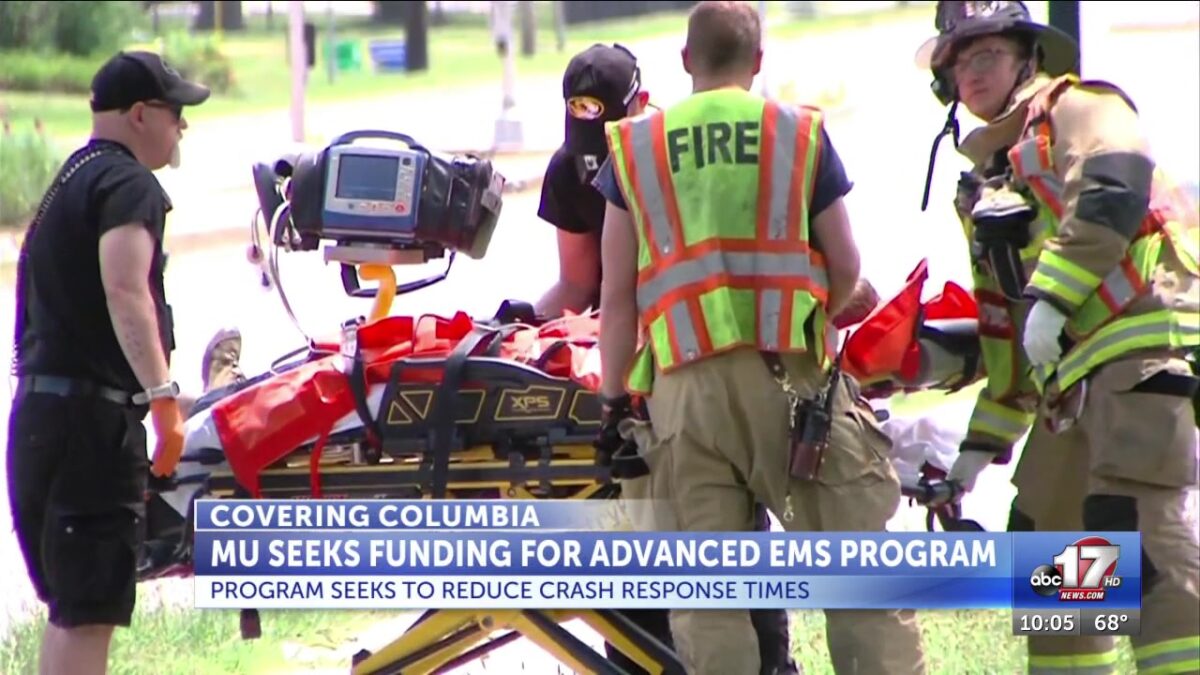MU seeks funding for advanced EMS program to cut crash response times

Mitchell Kaminski
COLUMBIA, Mo. (KMIZ)
The University of Missouri Department of Emergency Medicine is seeking funding to launch a new safety initiative aimed at improving emergency response times and outcomes for crash victims in Mid-Missouri.
The proposed initiative, called the Advanced Critical EMS Response Program, would temporarily equip a local emergency response vehicle with advanced care tools; such as blood products, a critical care ventilator and portable ultrasound equipment. The vehicle would also be staffed by specially trained clinicians.
Currently, these advanced resources are only available through helicopter transport, which often delays the delivery of life-saving care. MU officials say the goal of the program is to reduce that delay and improve patient outcomes.
“Just because the helicopter lands at the scene of the incident, doesn’t mean that they’re going to be back in the air flying to the hospital in just a few minutes,” Boone County Fire Protection District Assistant Chief Gale Blomenkamp said. “It takes some time. It takes a lot of coordination to make that transition.”
Blomenkamp said in many cases, ground crews can get patients to the hospital faster than air transport.
“Many times we can have a patient to University Hospital within our jurisdiction. We can get them there quicker than a helicopter can,” he said.
However, helicopters can be vital in certain situations, especially in complex rescues or poor road conditions.
“If we have an extended extraction, say we’ve got somebody trapped in the car that’s going to take us 30, 40 minutes to get them out, which it has happened, then the helicopter is probably our best bet,” Blomenkamp said. “They could be there and even start their treatment before we get the patient even out, which it has happened, then the helicopter is probably our best bet because they could be there and even start their treatment before we get the patient even out of that time and get them out of the car, we can load them into the helicopter and they can take off pretty quickly.”
Blomenkamp also noted that helicopters require preflight checks, which can delay response time by up to 10 minutes. In contrast, a ground EMS unit equipped with similar advanced tools could reach the scene faster.
“That equipment that’s normally carried on a helicopter, i.e., blood products… that can be there on the scene quicker, then that’s where that response time really helps,” Blomenkamp said. “So if you can do blood products or some of those other drugs and things that they carry on a helicopter to the scene by ground in 15, 20 minutes, you’re doing stuff there a lot quicker than if you wait for a helicopter.”
The University of Missouri’s Department of Emergency Medicine is currently requesting letters of support from stakeholders as part of its grant application. The deadline to apply is June 26.
One letter was recently sent to the Columbia Bicycle and Pedestrian Commission. In it, MU officials said the program could significantly reduce emergency response times and improve survival rates for critically injured patients.
“We will use pre-post studies to assess the scalability of the program and its effectiveness for reducing fatalities in Columbia, MO,” wrote Julie Stilley, associate research professor and director of emergency medicine research. “This information will inform future strategies that may be used in the City of Columbia’s Vision Zero policy.”
Stilley also attended the June 3 Vision Zero meeting to discuss how emergency response times can impact crash outcomes.
“Vision Zero’s goal is to reduce or eliminate traffic fatalities. So currently, the response time for serious injuries is pretty long,” Bicycle and Pedestrian Commission Chair Elke Boyd said. “What MU wants to do is, they want to do a study to see what the effect is of equipping one emergency response vehicle with similar equipment to a helicopter.”
Boyd also emphasized how faster response times would benefit the city’s most vulnerable road users.
“It’s a fact that nonmotorized users of traffic have a much higher mortality rate when they do get into an accident than people who are driving a vehicle because we don’t have that protective outer shell,” Boyd said. “Pedestrians, cyclists, and motorcycle riders are vulnerable road users that have a higher rate of death and injury. So we stand to particularly benefit from better response times.”
The commission drafted a letter of support, which was approved during their Wednesday night meeting.
For the third consecutive year, Missouri has seen a decline in traffic fatalities. According to the Missouri Department of Transportation, 954 people died in roadway crashes in 2024 — down 4% from 2023 and 10% from 2022. However, that still amounts to an average of 2.6 deaths per day.
The Missouri Coalition for Roadway Safety continues to emphasize that buckling up, putting phones down, slowing down and driving sober are key ways to prevent fatal crashes.
ABC 17 News has reached out to MU Health Care for comment.